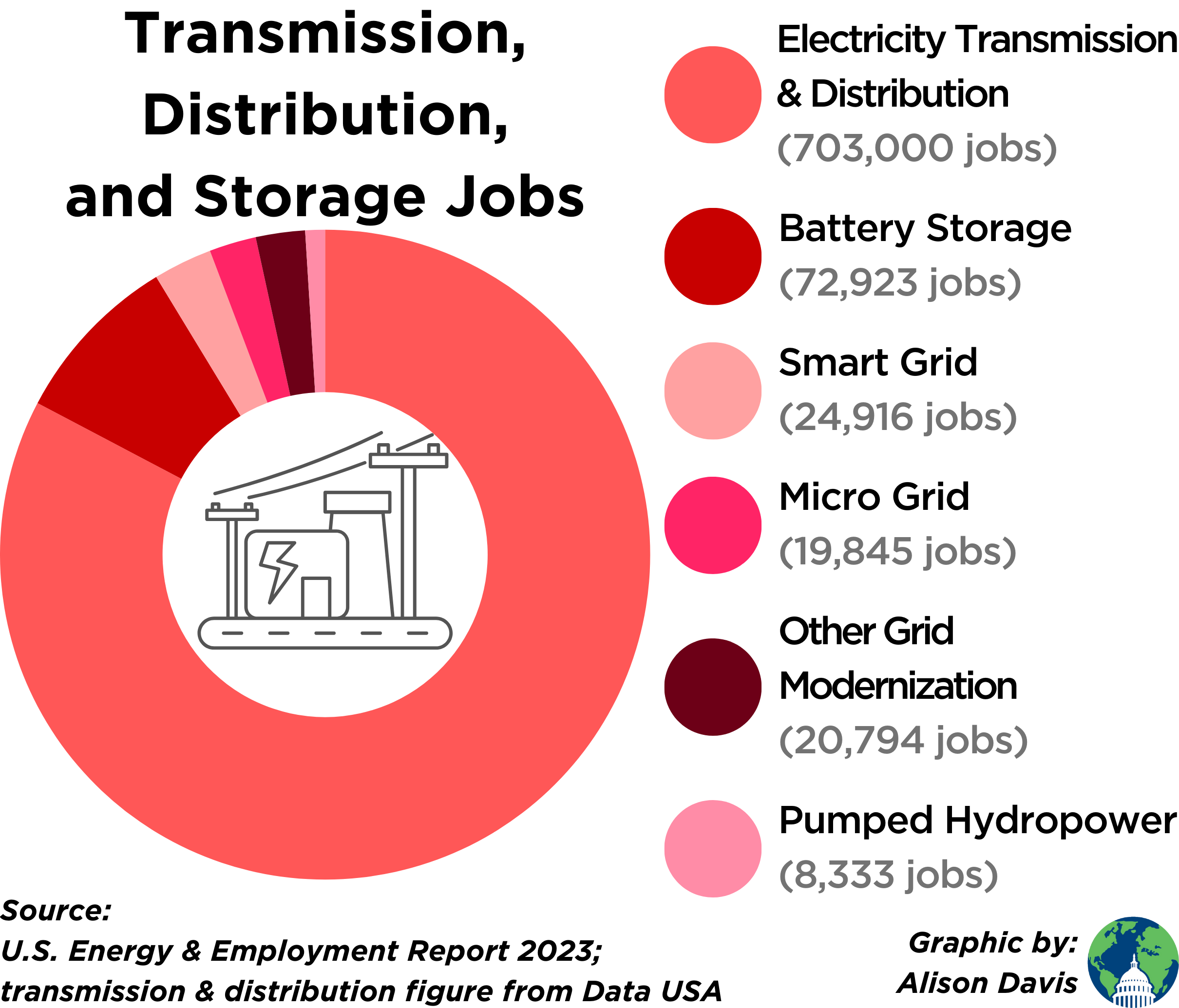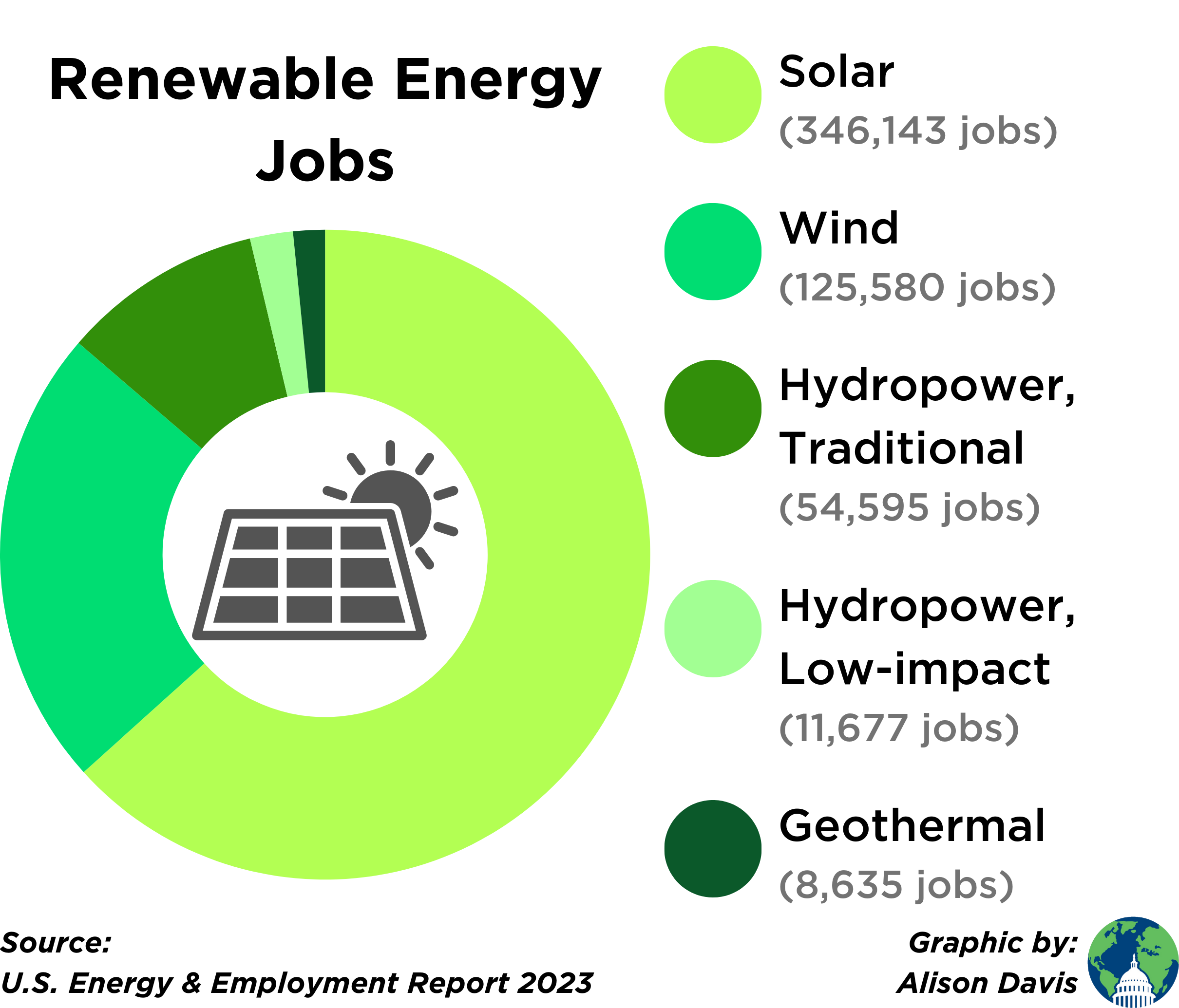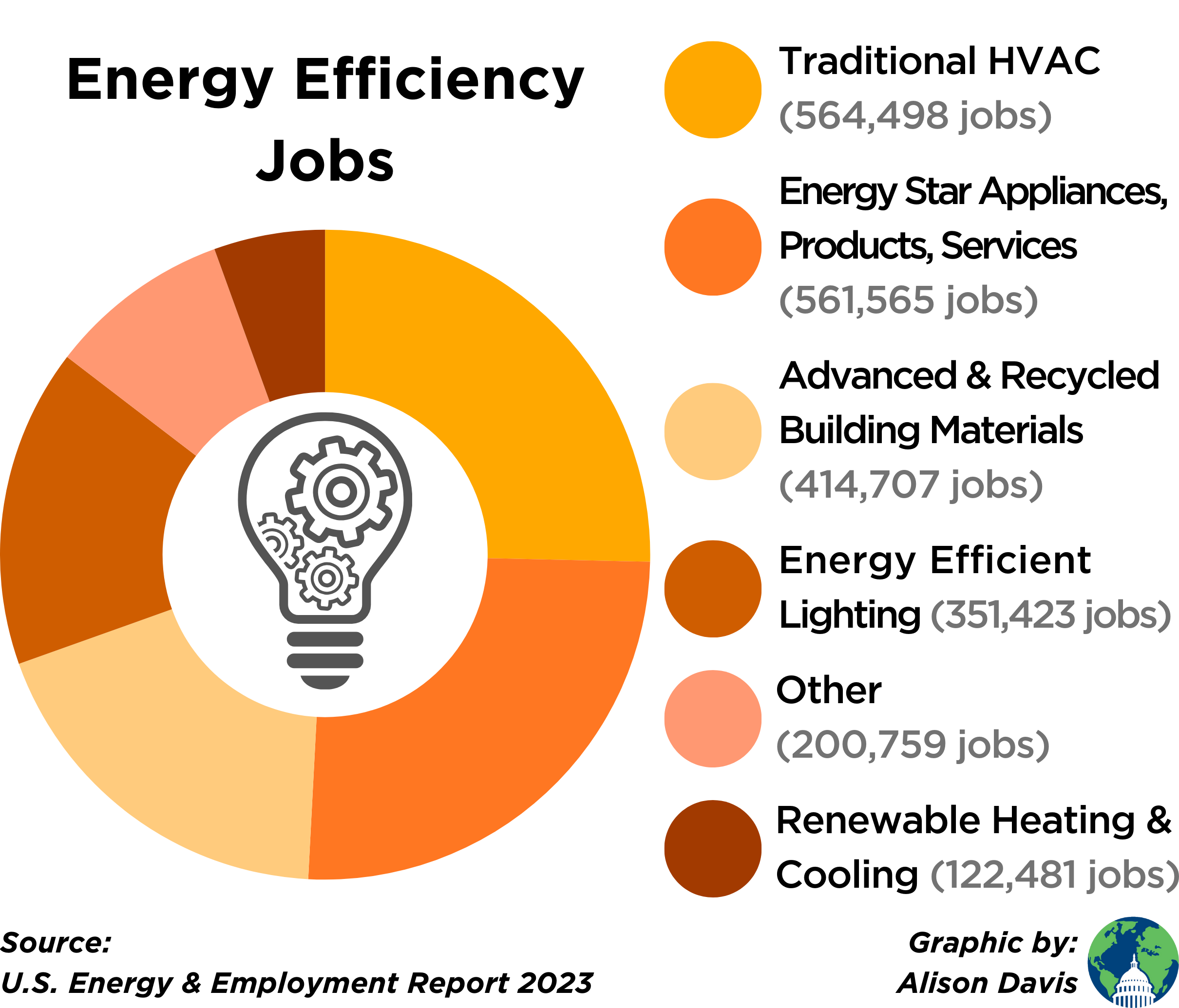U.S. efforts to confront the climate crisis have propelled a demand for jobs that will help the country mitigate and adapt to climate change. These climate jobs have been steadily on the rise in the United States. The energy sector as a whole has regained 71% of the jobs lost due to the pandemic in 2020. With a 3.9% growth rate, clean energy job creation outpaced overall job growth in 2022. In total, there were more than 4.2 million climate jobs in 2022.
Energy Efficiency Jobs
Energy efficiency supported 2.2 million jobs in 2022. This includes the work of designing, manufacturing, distributing, and installing energy-efficient products and services. Though remaining below pre-pandemic levels, every job category within this sector has experienced growth since 2021. The states with the most energy efficiency jobs in 2022 were California (294,396 jobs), Texas (164,470), New York (126,008), and Florida (118,904).
 Energy Transmission, Distribution, and Storage Jobs
Energy Transmission, Distribution, and Storage Jobs
In 2022, employment in clean energy storage and grid technology and modernization supported 146,811 jobs, while electricity transmission and distribution supported more than 703,000 jobs. Texas had the highest storage and grid-related employment (57,030), followed by California (50,787) and Illinois (20,662). The sector grew by 2.2% in 2022, with the highest growth rate (11.6%) occurring in electricity transmission and distribution system modernization (indicated by the label, “other grid modernization”).
 Renewable Energy Jobs
Renewable Energy Jobs
Renewable energy supported 546,630 jobs in 2022. Employment has increased across the sector since 2021, with wind energy experiencing the most growth (5,416 additional jobs). California had the highest number of solar, wind, and traditional hydropower jobs (133,173), followed by Texas (43,063) and New York (23,915). Solar and wind power continue to be the largest employers in renewable energy generation, and solar photovoltaic installers and wind turbine service technicians are among the 15 fastest-growing occupations in the United States.
Clean Transportation Jobs
Clean vehicles supported 373,605 jobs in 2022. This includes 152,846 jobs in hybrid electric vehicles, 134,060 jobs in battery electric vehicles, 68,925 jobs in plug-in hybrid vehicles, and 17,774 jobs in hydrogen/fuel cell vehicles. Overall, employment in the clean vehicle sector increased by 14.7% in 2022. Within this sector, battery electric vehicle employment saw the greatest increase, growing by almost 27%.
Renewable fuels supported 109,464 jobs in 2022. This includes about 35,152 jobs in corn ethanol, 20,939 jobs in other ethanol fuels, 34,164 jobs in woody biomass, and 19,209 jobs in other biofuels. Job growth for these fuels occurred across the board between 2021 and 2022, and was expected to continue into 2023.
Public transportation supported 821,220 jobs in 2022. Every $1 billion invested in public transportation can yield 50,000 jobs.
Adaptation and Resilience Jobs
As climate change impacts grow more frequent and severe, employment related to adaptation and resilience is rapidly emerging across many sectors, including natural resource management, transportation, infrastructure, public health, tourism, and disaster risk management. The American Society of Adaptation Professionals (ASAP) represents about 1,400 individuals and over 40 organizational members that employ more than 180,000 people. ASAP reports that at least 1,500 professional-level adaptation jobs were hired for in 2022. Though the total number of adaptation and resilience jobs is far greater, exact figures are unavailable. Adaptation jobs exist in all 50 states, with the most hiring opportunities in California; Washington, D.C.; Massachusetts; Texas; and New York. While new jobs are being created in this sector, existing jobs not traditionally considered to be climate jobs have begun to incorporate adaptation and resilience components as climate change intensifies. Job creation in this sector is expected to accelerate, especially with additional federal investment in adaptation and resilience—such as through the Federal Emergency Management Agency and the Infrastructure Investment and Jobs Act (P.L. 117-58).
Further developments in adaptation and resilience workforce tracking, such as revisions to the Standard Occupational Classification system, would aid analysis of employment in this sector. To learn more about adaptation jobs, check out EESI’s explainer, as well as EESI's methodology on estimating adaptation job numbers.
The Future of Climate Jobs
Since 2021, the passage and implementation of the Infrastructure Investment and Jobs Act (P.L. 117-58), the Inflation Reduction Act (IRA) (P.L. 117-169), and the CHIPS and Science Act (P.L. 117-167) have cemented long-term certainty for investment and work in the fields of energy efficiency, renewable energy, and climate resilience. Investments from the IRA alone are expected to create more than 303,500 jobs each year for new energy project construction, and about 100,000 permanent jobs every year. Within the law’s first six months, companies had already announced more than 100,000 new clean energy jobs. Climate and energy jobs will also continue to diversify, with new jobs addressing emerging issues such as abandoned oil and gas wells and decarbonization of the construction industry.
Author: Nicole Pouy
Editors: Daniel Bresette, Amaury Laporte
Source: https://www.eesi.org/papers/view/fact-sheet-climate-jobs-2024
